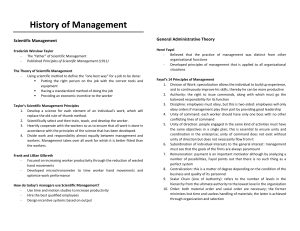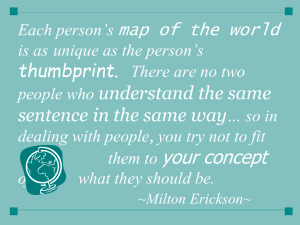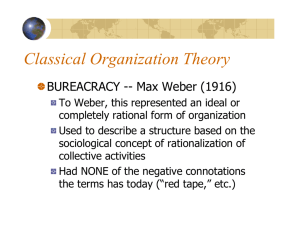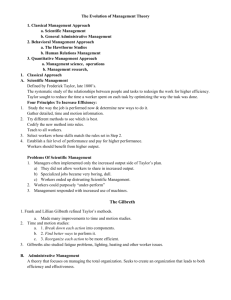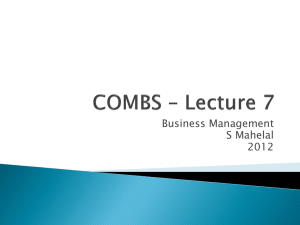Introduction to Management (Chapter 2)
advertisement
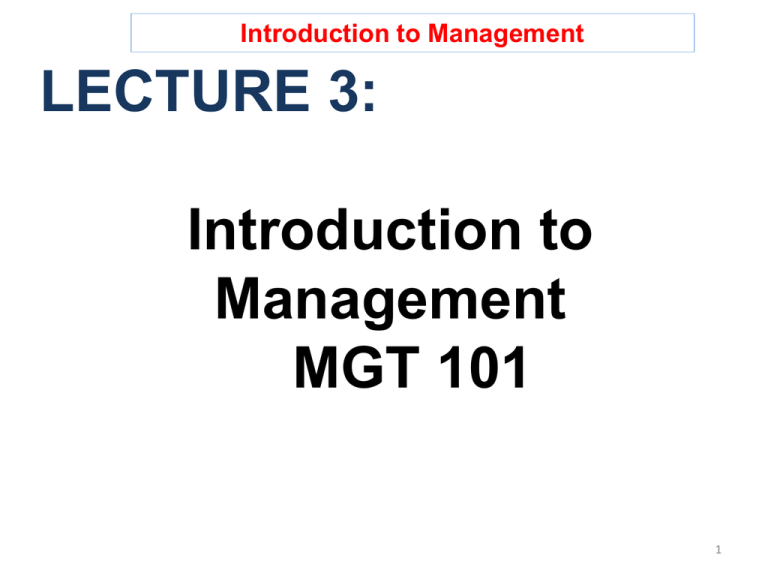
Introduction to Management LECTURE 3: Introduction to Management MGT 101 1 Introduction to Management In lecture 2 we discussed Topics from Chapter 1: • Skills Manager Require. • What is an Organization ? • Why Study Management ? Topics from Chapter 2 • Historical Background •Early examples of Management •Adam Smith •Industrial Revolution 2 Introduction to Management Today we will discuss Topics from Chapter 2 •Scientific Management •General Administrative Theories •Quantitative Approach •Organizational Behavior •Systems Approach 3 Introduction to Management (Chapter 2) Chapter 2: Management History 4 Introduction to Management (Chapter 2) Scientific Management 5 Introduction to Management (Chapter 2) Fredrick Winslow Taylor •The “father” of scientific management •Published Principles of Scientific Management (1911) 6 Introduction to Management (Chapter 2) •The theory of scientific management •Using scientific methods to define the “one best way” for a job to be done: •Putting the right person on the job with the correct tools and equipment. •Having a standardized method of doing the job. •Providing an economic incentive to the worker. 7 Introduction to Management (Chapter 2) Taylor’s Principles 1.Develop a science for each element of an individual’s work, which will replace the old rule-of-thumb method. 2.Scientifically select and then train, teach, and develop the worker. 8 Introduction to Management (Chapter 2) 3. Heartily cooperate with the workers so as to ensure that all work is done in accordance with the principles of the science that has been developed. 4. Divide work and responsibility almost equally between management and workers. Management takes over all work for which it is better fitted than the workers. 9 Introduction to Management (Chapter 2) Frank and Lillian Gilbreth •Focused on increasing worker productivity through the reduction of wasted motion •Developed the microchronometer to time worker motions and optimize work performance 10 Introduction to Management (Chapter 2) Henry Gantt 11 Introduction to Management (Chapter 2) How Do Today’s Managers Use Scientific Management? •Use time and motion studies to increase productivity •Hire the best qualified employees •Design incentive systems based on output 12 Introduction to Management (Chapter 2) General Administrative Theories 13 Introduction to Management (Chapter 2) Henri Fayol •Believed that the practice of management was distinct from other organizational functions •Developed principles of management that applied to all organizational situations 14 Introduction to Management (Chapter 2) Fayol’s 14 Principles 1. Division of work 7. Remuneration 2. Authority 8. Centralization 3. Discipline 9. Scalar chain 4. Unity of command 10. Order 5. Unity of direction 11. Equity 6. Subordination of individual interests to the general interest 12. Stability of tenure of personnel 13. Initiative 14. Esprit de corps 15 Introduction to Management LECTURE 4: Introduction to Management MGT 101 16 Introduction to Management In lecture 3 we discussed Topics from Chapter 2: • Scientific Management. • General Administrative Theories 17 Introduction to Management Today we will discuss Topics from Chapter 2 •General Administrative Theories •Quantitative Approach •Organizational Behavior 18 Introduction to Management (Chapter 2) Max Weber •Developed a theory of authority based on an ideal type of organization (bureaucracy) •The exercise of control on the basis of knowledge, expertise, or experience. •Emphasized rationality, predictability, impersonality, technical competence, and authoritarianism 19 Introduction to Management (Chapter 2) Weber’s Bureaucracy 1. Qualification-based hiring 2. Merit-based promotion 3. Chain of command 4. Division of labor 5. Impartial application of rules and procedures 6. Recorded in writing 7. Managers separate from owners 20 Introduction to Management (Chapter 2) Quantitative Approach 21 Introduction to Management (Chapter 2) •Also called operations research or management science •Evolved from mathematical and statistical methods developed to solve WWII military logistics and quality control problems •Focuses on improving managerial decision making by applying: •Statistics, optimization models, information models, and computer simulations 22 Introduction to Management (Chapter 2) Quality Management Intense focus on the customer Concern for continual improvement Process-focused Improvement in the quality of everything Accurate measurement Empowerment of employees 23 Introduction to Management (Chapter 2) Organizational Behavior 24 Introduction to Management (Chapter 2) 25 Introduction to Management (Chapter 2) Human Relations Management & Organizational Behavior •Efficiency alone is not enough to produce organizational success. •Success also depends on treating workers well. 26 Introduction to Management (Chapter 2) Hawthorne Studies A series of productivity experiments conducted at Western Electric from 1924 to 1932. 27 Introduction to Management (Chapter 2) •Experimental findings •Productivity unexpectedly increased under imposed adverse working conditions. •The effect of incentive plans was less than expected. •Research conclusion •Social norms, group standards and attitudes more strongly influence individual output and work behavior than do monetary incentives. 28 Introduction to Management (Chapter 2) Cooperation and Acceptance of Authority: Chester Barnard Managers can gain cooperation by: Securing essential services from individuals Unifying people by clearly formulating an organization’s purpose and objectives Providing a system of effective communication 29 Introduction to Management (Chapter 2) People will be indifferent to managerial directives if they… 1. are understood 2. are consistent with the purpose of the organization 3. are compatible with the people’s personal interests 4. can actually be carried out by those people 30 Introduction to Management (Chapter 2) Systems Approach 31 Introduction to Management (Chapter 2) System A set of interrelated and interdependent parts arranged in a manner that produces a unified whole. 32 Introduction to Management (Chapter 2) Basic Types of Systems Closed systems Are not influenced by and do not interact with their environment (all system input and output is internal). Open systems Dynamically interact to their environments by taking in inputs and transforming them into outputs that are distributed into their environments. 33 Introduction to Management (Chapter 2) 34 Introduction to Management (Chapter 2) 35 Introduction to Management (Chapter 2) Implications: •Coordination of the organization’s parts is essential for proper functioning of the entire organization. •Decisions and actions taken in one area of the organization will have an effect in other areas of the organization. •Organizations are not self-contained and, therefore, must adapt to changes in their external environment. 36
